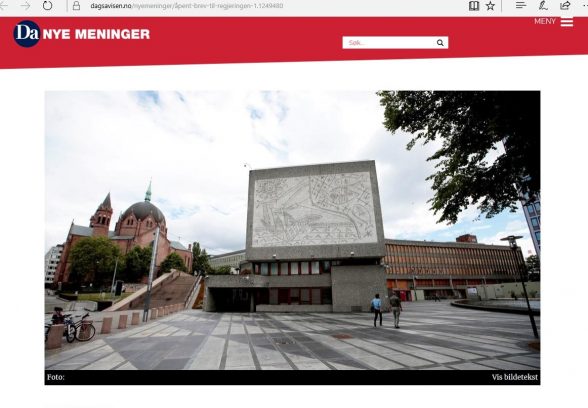This website uses cookies
This website uses cookies to enable it to function properly and to analyse how the website is used. Please click 'Close' to accept and continue using the website.



We don’t normally get involved in Casework beyond the UK, but sometimes we are asked to lend our support to campaigns abroad. In this case we not only really rate the building concerned (it was our building of the month in May 2016 https://c20society.org.uk/botm/y-block-oslo-norway/) but we are hoping to visit it on a future trip. We are therefore very pleased that a Norwegian daily newspaper Da Nye Meninger has published our letter against demolition of the Y-block building in Oslo.
C20 Society Director Catherine Croft wrote:
C20 Society urges The Norwegian Cabinet to reconsider the proposed demolition of The Y-block by Erling Viksjø (1910-1971). We featured this building as our “Building of the Month” in May 2016, and I was delighted to be able to visit Oslo and see it this summer. We regard the Y-building as a major work of C20 architecture, of international significance, both for the architectural quality of the building itself, and because of the extremely high quality of the murals by Picasso on its facade and in its lobby. It also makes a very positive contribution to the diverse cityscape around it.
We are currently organising an Architectural Study tour of Oslo, for our members and supporters, which will take place in August 2020. We very much hope that the Y-building will remain at this date, and that by then a positive future for it will have been secured. If this is the case, it will not only be an architectural highlight of our trip, but an extremely encouraging example of enlightened conservation practice, which we will be keen to celebrate.
Erling Viksjø was a distinguished architect with a particular expertise in working with reinforced concrete, and in pioneering decorative concrete finishes, a major field of research in the post war period. Working with the engineer Sverre Jystad, he co-invented a material and process known as Naturbetong which was patented in 1955. This allowed drawings to be inscribed on both interior and exterior fair-faced concrete surfaces, at a monumental scale, by very carefully controlled sandblasting. “The Seagull” mural in the lobby of the Oslo Y building was published in the UK on its completion, as a positive example of innovative design. Viksjø was the first recipient of the prestigious Betongtavlen award from the National Association of Norwegian Architects and the Norwegian Concrete Association. He was accorded this honour twice, once in 1961 for his Bakkehaugen Church and again in 1963 for Tromsø Bridge. The award is for a structure where concrete is used in an environmentally, aesthetically and technically excellent way—I can think of no better example of such success.
We appreciate that the terrorist attacks on the 22th July 2011 were of a profoundly shocking nature, and that they remain very current in Norwegian consciousness, in particular. However, we do not feel that this difficult legacy is best addressed by demolition. Restoration of the Y-building is possible, Picasso’s art works have both survived intact, and concerns about vulnerability due to the roadway beneath part of the building could be straightforwardly addressed by sensitive interventions which themselves could facilitate future use. This would be a far stronger symbolic response to the atrocities of that day.
Here in London, we were involved when the security concerns led to the consideration of major alterations and possible demolition of the Eero Saarinen-designed US Embassy in London, because it was considered otherwise indefensible according to post 9/11 security standards. Nevertheless, we put it forward for listing in 2007, and after over two years of intense debate, were very pleased that it was listed at Grade II. The final result has been very satisfactory. There is now a new US Embassy at a different location, where there is space to address security issues to the Pentagon’s satisfaction, and the listed Saarinen building will shortly open as a hotel designed by Royal Institute of British Architecture Royal Gold Medal and Stirling Prize winning architect, Sir David Chipperfield. Thus the historic building will have a beneficial reuse (and one that allows public access) and the new Embassy has been instrumental in the revitalisation of a previously little visited part of the city.
I note that Picasso’s friezes on the Architects’ College of Catalonia, in Barcelona, (his other project in this medium) are recognised as a visitor attraction to the city, and that the recent 50th anniversary of the construction of this building was celebrated.
Demolition of the building would be a major act of cultural destruction, and represent the irreparable loss of loss of a major cultural asset of extreme historic significance. Relocation of the murals would provide very inadequate mitigation, as it is their relationship to both the architecture of the Y building, and the broader context of the public realm from which they may be viewed, as well as the Picasso murals in the adjacent Highrise building, is crucial to their significance.
We understand that in 2011 both The Highrise and The Y-block were scheduled to be listed for the highest level of heritage protection, and urge you to consider confirming listing at this point. We further urge you to seek a beneficial reuse of the Y building, for government purposes or otherwise. Attitudes to C20 architecture are changing very rapidly, and Brutalism in particular is fast gaining a very high reputation as an international style and phenomenon Concerns over the long term robustness of concrete are abating, and many recent projects have demonstrated how buildings of this period can be successful made energy efficient.
It would be tragic if the Y building were not to be preserved for future generations to appreciate and enjoy.

Become a C20 member today and help save our modern design heritage.